Page 390 of 703
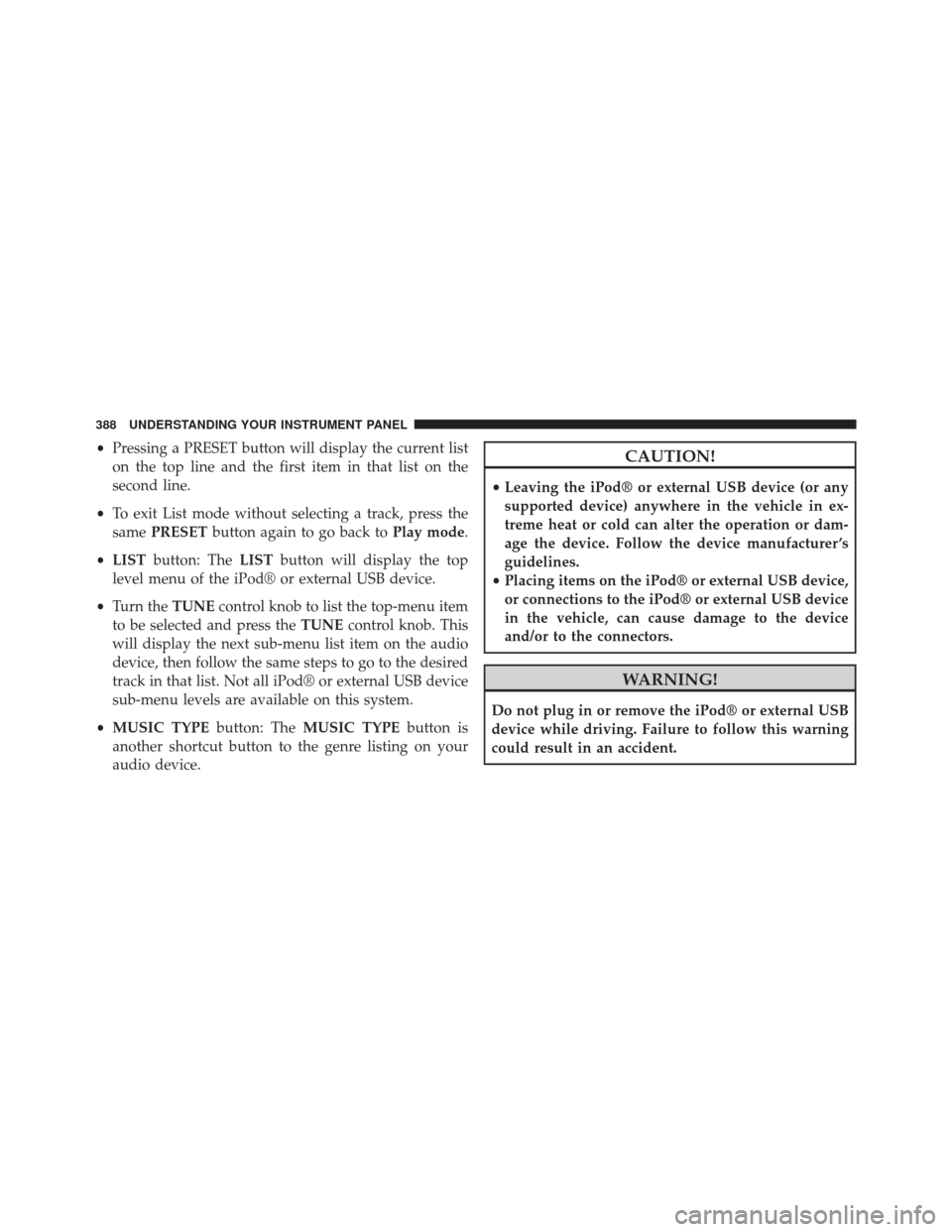
•Pressing a PRESET button will display the current list
on the top line and the first item in that list on the
second line.
• To exit List mode without selecting a track, press the
same PRESET button again to go back to Play mode.
• LIST button: The LISTbutton will display the top
level menu of the iPod® or external USB device.
• Turn the TUNEcontrol knob to list the top-menu item
to be selected and press the TUNEcontrol knob. This
will display the next sub-menu list item on the audio
device, then follow the same steps to go to the desired
track in that list. Not all iPod® or external USB device
sub-menu levels are available on this system.
• MUSIC TYPE button: TheMUSIC TYPE button is
another shortcut button to the genre listing on your
audio device.CAUTION!
• Leaving the iPod® or external USB device (or any
supported device) anywhere in the vehicle in ex-
treme heat or cold can alter the operation or dam-
age the device. Follow the device manufacturer ’s
guidelines.
• Placing items on the iPod® or external USB device,
or connections to the iPod® or external USB device
in the vehicle, can cause damage to the device
and/or to the connectors.
WARNING!
Do not plug in or remove the iPod® or external USB
device while driving. Failure to follow this warning
could result in an accident.
388 UNDERSTANDING YOUR INSTRUMENT PANEL
Page 426 of 703
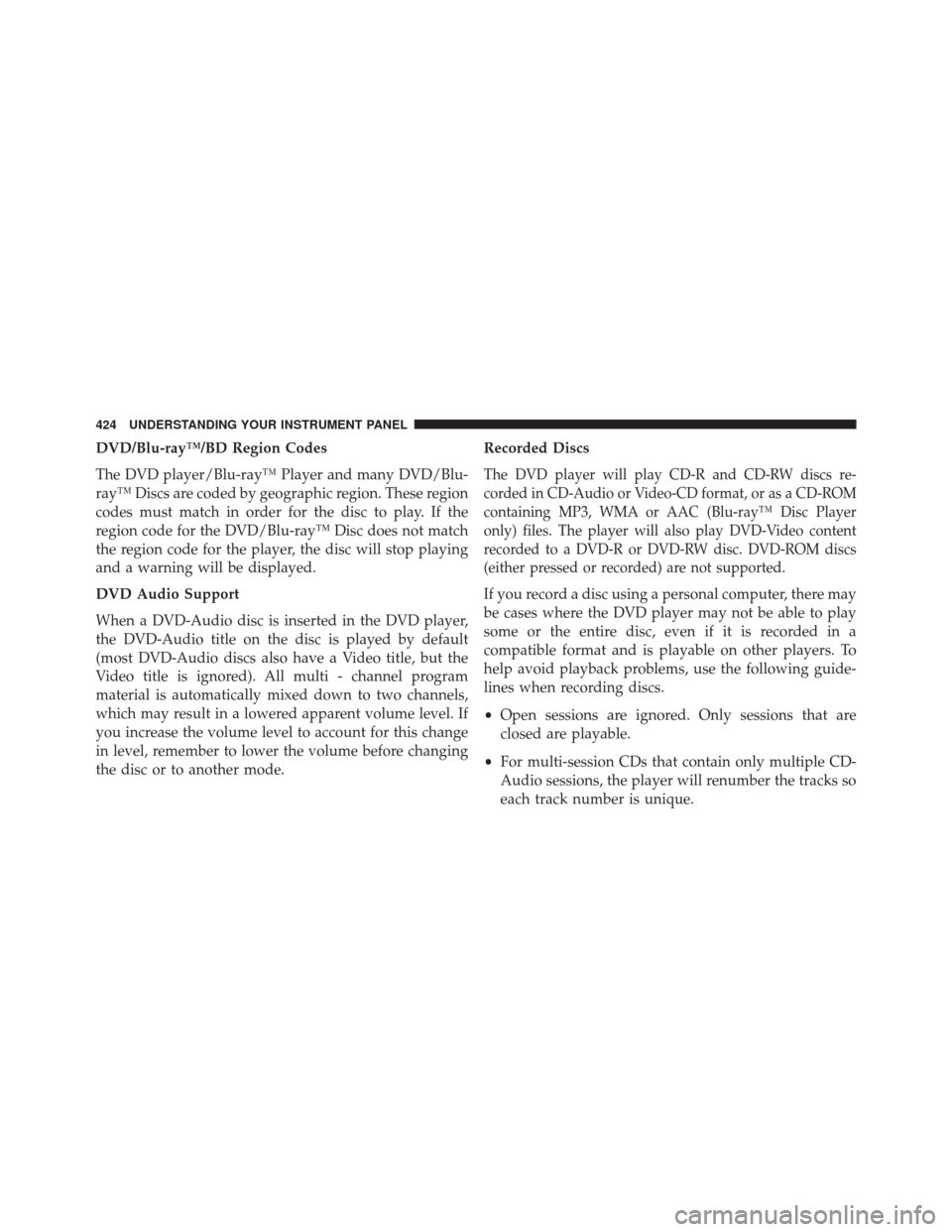
DVD/Blu-ray™/BD Region Codes
The DVD player/Blu-ray™ Player and many DVD/Blu-
ray™ Discs are coded by geographic region. These region
codes must match in order for the disc to play. If the
region code for the DVD/Blu-ray™ Disc does not match
the region code for the player, the disc will stop playing
and a warning will be displayed.
DVD Audio Support
When a DVD-Audio disc is inserted in the DVD player,
the DVD-Audio title on the disc is played by default
(most DVD-Audio discs also have a Video title, but the
Video title is ignored). All multi - channel program
material is automatically mixed down to two channels,
which may result in a lowered apparent volume level. If
you increase the volume level to account for this change
in level, remember to lower the volume before changing
the disc or to another mode.Recorded Discs
The DVD player will play CD-R and CD-RW discs re-
corded in CD-Audio or Video-CD format, or as a CD-ROM
containing MP3, WMA or AAC (Blu-ray™ Disc Player
only) files. The player will also play DVD-Video content
recorded to a DVD-R or DVD-RW disc. DVD-ROM discs
(either pressed or recorded) are not supported.
If you record a disc using a personal computer, there may
be cases where the DVD player may not be able to play
some or the entire disc, even if it is recorded in a
compatible format and is playable on other players. To
help avoid playback problems, use the following guide-
lines when recording discs.
•
Open sessions are ignored. Only sessions that are
closed are playable.
• For multi-session CDs that contain only multiple CD-
Audio sessions, the player will renumber the tracks so
each track number is unique.
424 UNDERSTANDING YOUR INSTRUMENT PANEL
Page 460 of 703
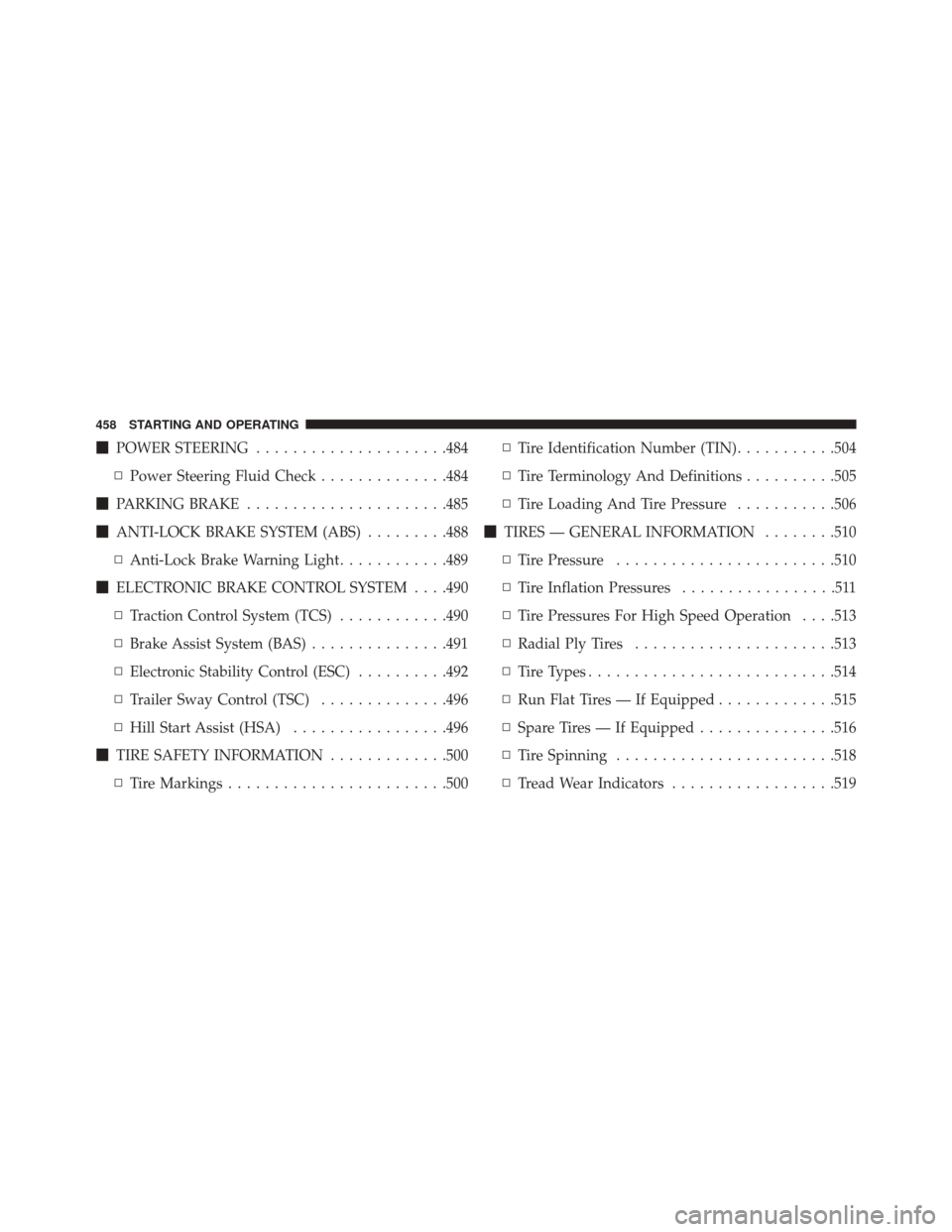
�POWER STEERING .....................484
▫ Power Steering Fluid Check ..............484
� PARKING BRAKE ..................... .485
� ANTI-LOCK BRAKE SYSTEM (ABS) .........488
▫ Anti-Lock Brake Warning Light ............489
� ELECTRONIC BRAKE CONTROL SYSTEM . . . .490
▫ Traction Control System (TCS) ............490
▫ Brake Assist System (BAS) ...............491
▫ Electronic Stability Control (ESC) ..........492
▫ Trailer Sway Control (TSC) ..............496
▫ Hill Start Assist (HSA) .................496
� TIRE SAFETY INFORMATION .............500
▫ Tire Markings ....................... .500▫
Tire Identification Number (TIN) ...........504
▫ Tire Terminology And Definitions ..........505
▫ Tire Loading And Tire Pressure ...........506
� TIRES — GENERAL INFORMATION ........510
▫ Tire Pressure ....................... .510
▫ Tire Inflation Pressures .................511
▫ Tire Pressures For High Speed Operation . . . .513
▫ Radial Ply Tires ..................... .513
▫ Tire Types .......................... .514
▫ Run Flat Tires — If Equipped .............515
▫ Spare Tires — If Equipped ...............516
▫ Tire Spinning ....................... .518
▫ Tread Wear Indicators ..................519
458 STARTING AND OPERATING
Page 461 of 703

▫Life Of Tire ........................ .519
▫ Replacement Tires .....................520
� TIRE CHAINS (TRACTION DEVICES) .......522
� TIRE ROTATION RECOMMENDATIONS .....523
� TIRE PRESSURE MONITOR SYSTEM (TPMS) . .524
▫ Base System ........................ .527
▫ Premium System — If Equipped ...........529
� FUEL REQUIREMENTS ..................533
▫ 3.6L Engine ......................... .533
▫ Reformulated Gasoline .................534
▫ Gasoline/Oxygenate Blends ..............534
▫ E-85 Usage In Non-Flex Fuel Vehicles .......535
▫ MMT In Gasoline .....................535 ▫
Materials Added To Fuel ................536
▫ Fuel System Cautions ...................536
▫ Carbon Monoxide Warnings .............537
� FLEXIBLE FUEL — IF EQUIPPED ...........538
▫ E-85 General Information ...............538
▫ Ethanol Fuel (E-85) ....................539
▫ Fuel Requirements ....................539
▫ Selection Of Engine Oil For Flexible Fuel Vehicles
(E-85) And Gasoline Vehicles .............540
▫ Starting ........................... .541
▫ Cruising Range ...................... .541
▫ Replacement Parts ....................541
▫ Maintenance ....................... .541
5
STARTING AND OPERATING 459
Page 463 of 703
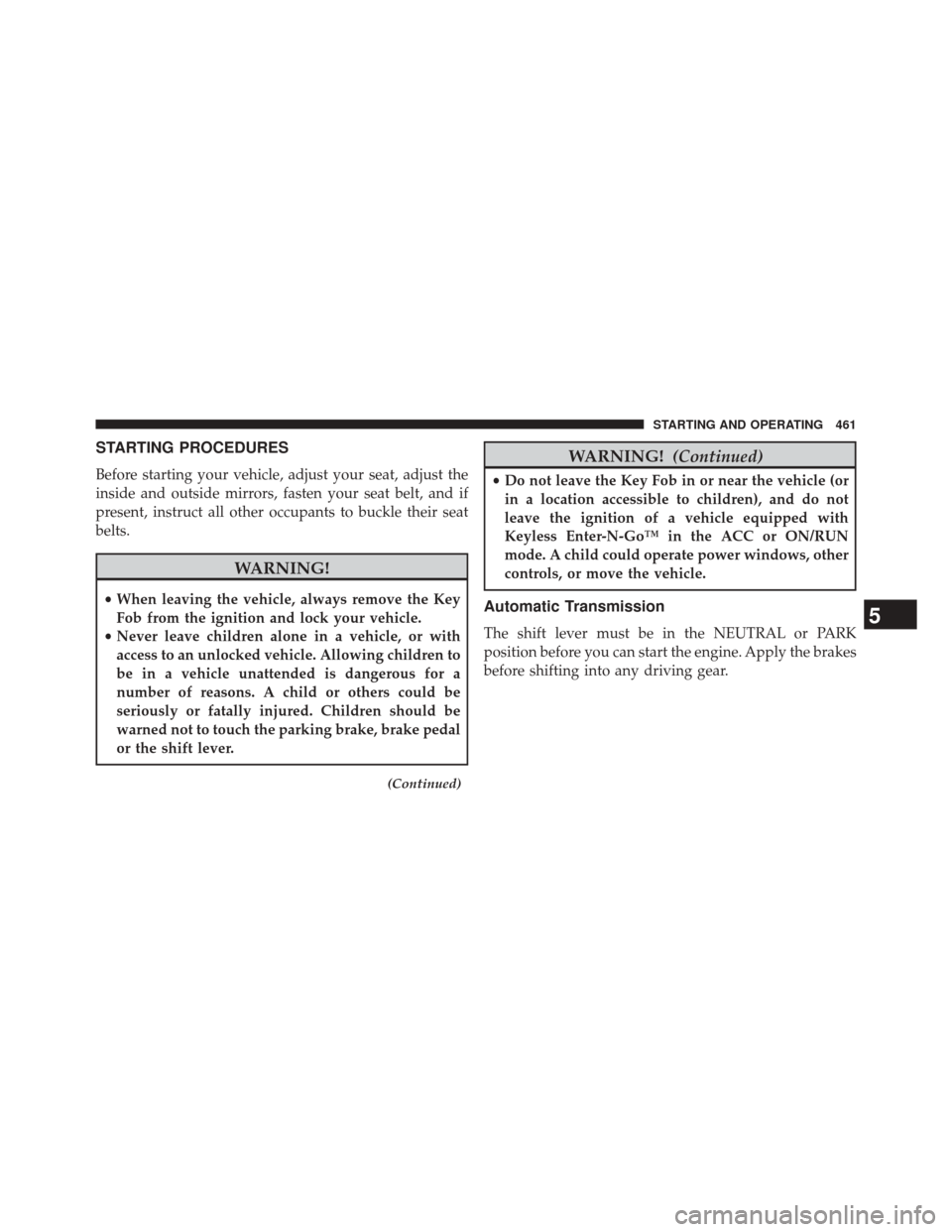
STARTING PROCEDURES
Before starting your vehicle, adjust your seat, adjust the
inside and outside mirrors, fasten your seat belt, and if
present, instruct all other occupants to buckle their seat
belts.
WARNING!
•When leaving the vehicle, always remove the Key
Fob from the ignition and lock your vehicle.
• Never leave children alone in a vehicle, or with
access to an unlocked vehicle. Allowing children to
be in a vehicle unattended is dangerous for a
number of reasons. A child or others could be
seriously or fatally injured. Children should be
warned not to touch the parking brake, brake pedal
or the shift lever.
(Continued)
WARNING! (Continued)
•Do not leave the Key Fob in or near the vehicle (or
in a location accessible to children), and do not
leave the ignition of a vehicle equipped with
Keyless Enter-N-Go™ in the ACC or ON/RUN
mode. A child could operate power windows, other
controls, or move the vehicle.
Automatic Transmission
The shift lever must be in the NEUTRAL or PARK
position before you can start the engine. Apply the brakes
before shifting into any driving gear.5
STARTING AND OPERATING 461
Page 467 of 703
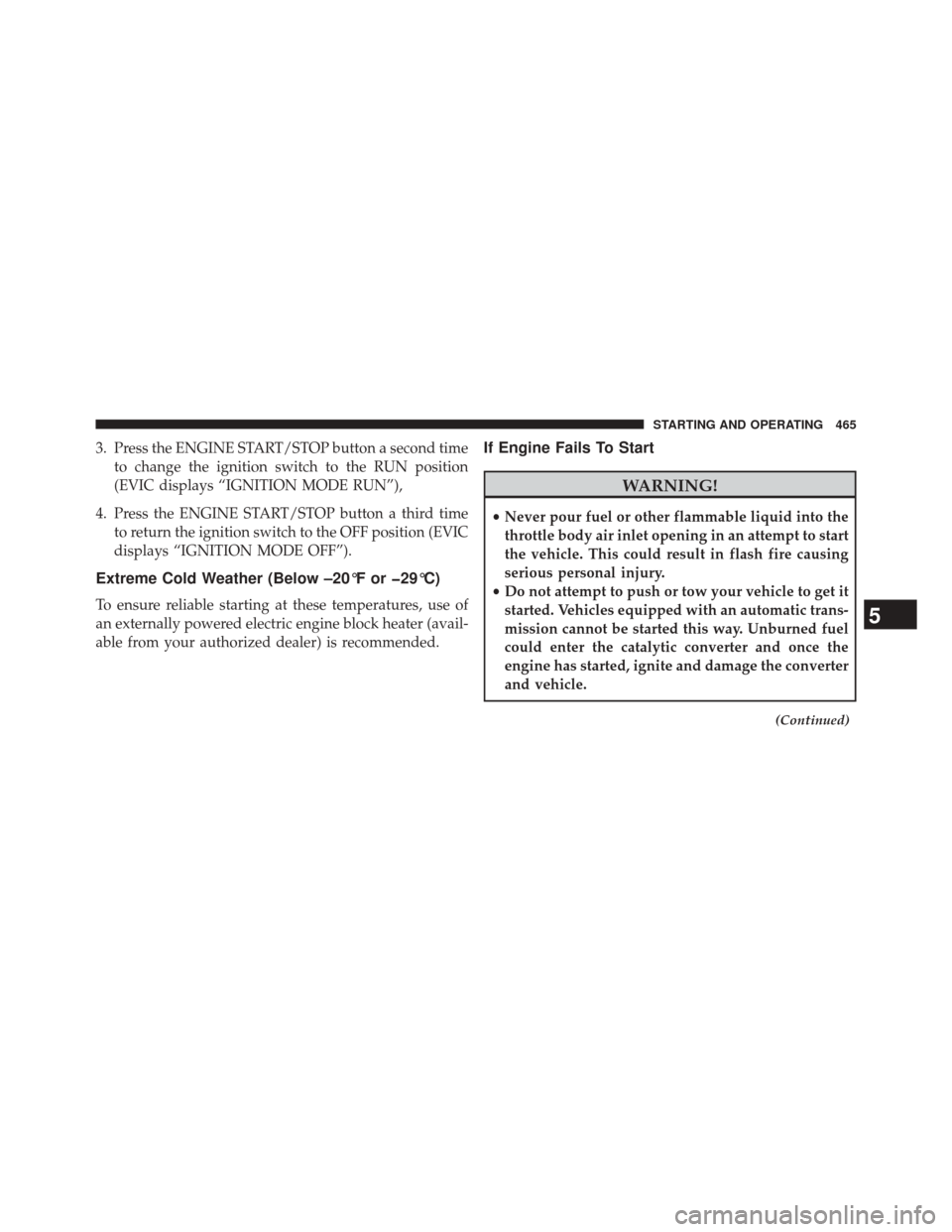
3. Press the ENGINE START/STOP button a second timeto change the ignition switch to the RUN position
(EVIC displays “IGNITION MODE RUN”),
4. Press the ENGINE START/STOP button a third time to return the ignition switch to the OFF position (EVIC
displays “IGNITION MODE OFF”).
Extreme Cold Weather (Below –20°F or �29°C)
To ensure reliable starting at these temperatures, use of
an externally powered electric engine block heater (avail-
able from your authorized dealer) is recommended.
If Engine Fails To Start
WARNING!
•Never pour fuel or other flammable liquid into the
throttle body air inlet opening in an attempt to start
the vehicle. This could result in flash fire causing
serious personal injury.
• Do not attempt to push or tow your vehicle to get it
started. Vehicles equipped with an automatic trans-
mission cannot be started this way. Unburned fuel
could enter the catalytic converter and once the
engine has started, ignite and damage the converter
and vehicle.
(Continued)
5
STARTING AND OPERATING 465
Page 468 of 703

WARNING!(Continued)
•If the vehicle has a discharged battery, booster
cables may be used to obtain a start from a booster
battery or the battery in another vehicle. This type
of start can be dangerous if done improperly. Refer
to “Jump Starting” in “What To Do In Emergen-
cies” for further information.
Clearing A Flooded Engine (Using ENGINE
START/STOP Button)
If the engine fails to start after you have followed the
“Normal Starting” or “Extreme Cold Weather� proce-
dures, it may be flooded. To clear any excess fuel:
1. Press and hold the brake pedal.
2. Press the accelerator pedal all the way to the floor and hold it. 3. Press and release the ENGINE START/STOP button
once.
The starter motor will engage automatically, run for 10
seconds, and then disengage. Once this occurs, release
the accelerator pedal and the brake pedal, wait 10 to 15
seconds, then repeat the “Normal Starting” procedure.
Clearing A Flooded Engine (Using Fob With
Integrated Key)
If the engine fails to start after you have followed the
“Normal Starting” or “Extreme Cold Weather” proce-
dures, it may be flooded. To clear any excess fuel:
1. Press the accelerator pedal all the way to the floor and hold it.
2. Place the ignition in the START position and release it as soon as the starter engages.
466 STARTING AND OPERATING
Page 469 of 703
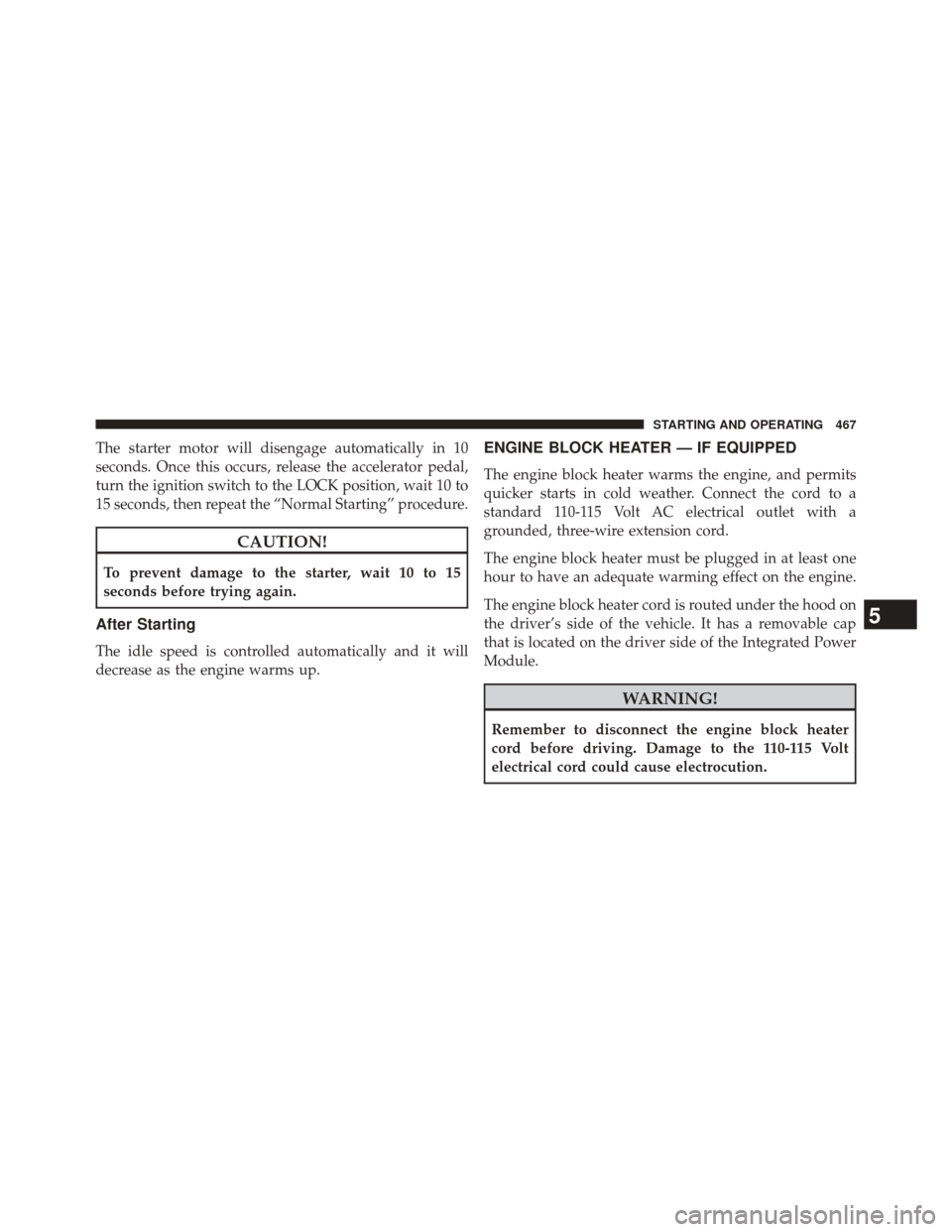
The starter motor will disengage automatically in 10
seconds. Once this occurs, release the accelerator pedal,
turn the ignition switch to the LOCK position, wait 10 to
15 seconds, then repeat the “Normal Starting” procedure.
CAUTION!
To prevent damage to the starter, wait 10 to 15
seconds before trying again.
After Starting
The idle speed is controlled automatically and it will
decrease as the engine warms up.
ENGINE BLOCK HEATER — IF EQUIPPED
The engine block heater warms the engine, and permits
quicker starts in cold weather. Connect the cord to a
standard 110-115 Volt AC electrical outlet with a
grounded, three-wire extension cord.
The engine block heater must be plugged in at least one
hour to have an adequate warming effect on the engine.
The engine block heater cord is routed under the hood on
the driver’s side of the vehicle. It has a removable cap
that is located on the driver side of the Integrated Power
Module.
WARNING!
Remember to disconnect the engine block heater
cord before driving. Damage to the 110-115 Volt
electrical cord could cause electrocution.
5
STARTING AND OPERATING 467